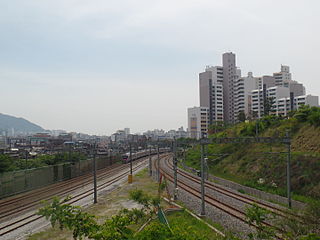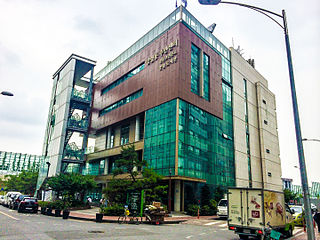
Gangdong District (Gangdong-gu) is one of the 25 gu which makes up the city of Seoul. Gangdong, literally means "east of river".

Jungnang District (Jungnang-gu) is one of the 25 gu, or districts, of Seoul, South Korea. It is located on the north side of the Han River.

Sangil-dong station is the subway station of Line 5 in Gangdong-gu, Seoul. Seoul Metro have extended the subway line from this station to Hanam Geomdansan in the nearby city of Hanam.

Ilmin Museum of Art is a private art museum of South Korea, located on Sejongno street in Jongno-gu, a central district of Seoul, known for exhibiting mainly Korean art. The museum was established and run by the Ilmin Cultural Foundation (Korean: 일민문화재단), a non-profit organization founded in 1994 in memory of Kim Sang-man, former president of Dong-A Ilbo, one of the major newspaper companies of South Korea. Kim devoted his entire life to developing Korean journalism and promoting Korean culture. The museum is named after his pen name, "Ilmin".

Pungnap-dong is a neighbourhood, dong of Songpa-gu, Seoul, South Korea.
Susaek-dong is a dong, neighbourhood of Eunpyeong-gu in Seoul, South Korea.

Amsa-dong is a dong (neighbourhood) of Gangdong-gu in Seoul, South Korea. The dong is well known for the Amsa-dong Prehistoric Settlement Site, in which Neolithic remains were excavated after a large amount of diagonal-line patterned earthenware was exposed by a flood in 1925.

Cheonho-dong (Korean: 천호동) is a dong, neighbourhood of Gangdong-gu in Seoul, South Korea.

Seongnae-dong is a dong, neighbourhood of Gangdong-gu in Seoul, South Korea.

Gangil-dong is a dong, neighbourhood of Gangdong-gu in Seoul, South Korea.

Dunchon-dong is a dong, neighbourhood of Gangdong-gu in Seoul, South Korea.

Gil-dong is a dong, neighbourhood of Gangdong District in Seoul, South Korea.
Myeongil-dong is a dong, neighbourhood of Gangdong-gu in Seoul, South Korea.
Sangil-dong is a dong, neighbourhood of Gangdong-gu in Seoul, South Korea.

Hoehyeon-dong is a dong, neighbourhood of Jung-gu in Seoul, South Korea.

Sindang-dong (Korean: 신당동) is a dong, neighbourhood of Jung-gu in Seoul, South Korea.
Jeong-dong is a legal dong, or neighbourhood of the Jung-gu district in Seoul, South Korea and governed by its administrative dong, Sogong-dong.
Jugyo-dong is a legal dong, or neighbourhood of the Jung-gu district in Seoul, South Korea. It is governed by its administrative dong, Euljiro 3, 4, 5ga-dong.

Seongsu-dong (Korean: 성수동) is a dong, or neighbourhood, of Seongdong-gu in Seoul, South Korea. It is further subdivided into Seongsu-dong 1-ga and Seongsu-dong 2-ga, and is served by Ttukseom Station and Seongsu Station on Seoul Subway Line 2 and by Seoul Forest Station on the Suin-Bundang Line. Its most notable attraction is Seoul Forest, a public park. The neighborhood has become popular in recent years for its array of cafes and restaurants, many of which have been set up in repurposed factories and old residential buildings, earning it the nickname "The Brooklyn of Seoul". There are also various stores built inside repurposed shipping containers.
Bongwon-dong is a legal dong, neighbourhood of the Seodaemun-gu district in Seoul, South Korea and is governed by its administrative dong, Sinchon-dong's office. Bongwon-dong has the Bongwon-Temple(Bongwonsa) built by Great master Doseon (827–898) in 889, 3rd year of Jinseong Queen, the 51st of Shilla Dynasty. Bongwon-Temple gives opportunities for visitors to experience "Seoul Lotus Festival" and "Yeongsamjae ritual" annually.














